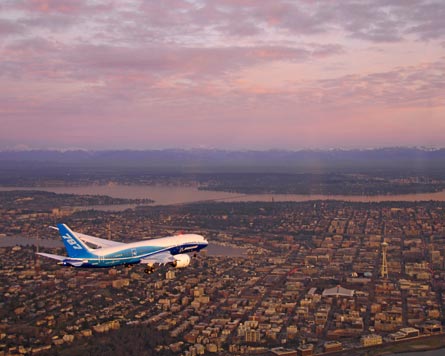Data obtained by Flight International shows Boeing's historic order backlog for the 787 was based partly on steep discounts driven by now-discarded design and manufacturing assumptions.
Cost overruns, penalty payments and supply chain changes adopted in the past two years will force Boeing to achieve unprecedented cost savings for the widebody to turn a profit even after delivering the current 846-aircraft backlog.
With first delivery nearly three years behind schedule, the cost to build each 787 has skyrocketed from original assumptions of lower and more predictable production costs, say company insiders.
 |
|---|
© Boeing |
In the race to sign up customers between 2004 and 2006, airframe prices averaged just below $76 million, a price that does not include the $20-30 million GENx or Rolls-Royce engines, buyer furnished equipment and in-flight entertainment, according to pricing data.
While Boeing will probably never disclose the actual prices for which its mega-backlog of 787s were sold, chief executive Jim Albaugh acknowledged in a recent interview: "I think we gave away some of the value of this airplane to a lot of our customers."
Customer and company sources, as well as industry analysts, say that statement is an understated acknowledgment that Boeing's huge 787 backlog was fuelled not only by predictions of huge future growth in air travel and sharply-rising fuel prices - but by a steady and strategic drop in the price of the aircraft.
In late 2004, Boeing started employing aggressive, price-cutting sales tactics, according to sources familiar with the pricing discussions, blunting the ambitions of the original Airbus A350, which at that time was an A330 update rather than the all-new aircraft in development today.
In the more than three and a half years since its first 787 began assembly, the prevailing wisdom about Boeing's woes have centred upon moving past manufacturing design issues, completing extensive rework of production airframes, certificating and delivering the first units for revenue service and building a steady industrial ramp-up at its Everett and Charleston facilities; all while rebalancing its supply chain as it develops the 787-8's larger successor.
Although each is a formidable task, the pricing data indicates Boeing also must overcome five-year-old pricing decisions on more than 300 787s still in the backlog.
The 2004-06 airframe prices charged to airline customers ranged from $83.5 million down to $65.7 million for the 787-8 for one higher-volume deal with a blue-chip customer.
There remains great risk and opportunity to ensure the 787 - the company's fastest selling jetliner - becomes the cash cow Boeing hopes it will become. Few doubt the market success of Boeing's flagship programme, although the profitability and margins remain open questions as the recurring production costs, by the company's own admission, lack clarity.
The steadily lowered price for the Dreamliner was supported by the barebones production costs forecast by programme planners who saw a global supply chain with its contractual prices locked in, as well as design and manufacturing responsibility and cost weighted toward Boeing's suppliers.
Boeing's supply chain model as formulated, say company insiders, allowed the estimate of its "snap together planes" to be built for an unprecedented contractually locked-in low recurring cost that would be recognised early in the programme as the production rate was set to reach 10 aircraft a month in 2010.
This cost assumption, built upon a $5 billion investment for the 787, say industry sources, compared with the $11.5 billion initially budgeted for the 777, allowed Boeing to compete aggressively to establish the Dreamliner in the marketplace, ultimately obliterating the earliest incarnations of the A350.
Boeing chief financial officer James Bell says it will be another three to four years before Boeing can anticipate if it will approach the profitability of the 777 and 737, the company's most mature programmes.
"We would also have a real opportunity to see how the production system really works, because remember," says Bell, "this is a different production system than we used on building aluminium airplanes, and we anticipate that with the learning curve on that we will be able to harvest sooner. But we won't know that until we start running them.
"But by 2013, 2014, we will know. We would expect those margins to start to approach some of the production programmes you see today."
To ensure the poor pricing locked in on the first several hundred 787-8s do not significantly drop the company's quarterly reported profits, say analysts, Boeing is spreading out the poorly priced airframes over the delivery schedule in the decade to come, interspersed with better prices locked in with later customers. Shifting poorly priced units farther along Boeing's "skyline" also allows a drop in the cost to build each 787 as the production rate accelerates.
That acceleration, say factory sources, may extend well beyond today's 2013 goal to build 10 787s a month, with rises as high as 17 a month being investigated for mid-2016.
Source: Flight International



















